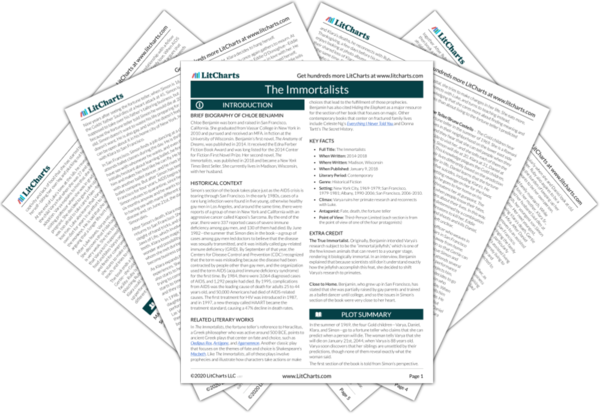Fate vs. Choice
The Immortalists follows the four Gold siblings—Simon, Klara, Daniel, and Varya—who when the novel begins are part of a Jewish family living in Manhattan in the 1960s. In the book’s opening scene, the siblings visit a local fortune teller, who predicts the exact date of each child’s death. Simon’s and Klara’s deaths are predicted to happen when they’re relatively young, so they try to take advantage of the little…
read analysis of Fate vs. ChoiceObsession
Several of the central Gold siblings are plagued by obsessive thoughts. Klara believes that her younger brother Simon and father Saul are trying to speak to her from beyond the grave; Daniel fixates on the fortune teller who predicted his and his siblings’ dates of death; and Varya is consumed by anxiety about avoiding any kind of harm or disease. In each case, these obsessive, all-consuming thoughts lead the characters to ruin—and in some cases…
read analysis of Obsession
Death, Meaning, and Legacy
Throughout The Immortalists, death is at the forefront of the Gold family’s lives, particularly after a fortune teller provides each of the four Gold children with their exact date of death. Yet the fortune teller simply raises awareness of what all humans know to be true: every person’s time on earth is limited. As the book’s characters grapple with their mortality, the book suggests that finding meaning in life lies not in trying to…
read analysis of Death, Meaning, and LegacySurviving vs. Living
The Immortalists explores whether a longer life is necessarily a better one. Varya investigates this question specifically through her work as a biologist, studying primates in order to find ways to extend the human lifespan. Varya even tries to follow some of the experiment’s hypotheses herself: she severely limits her diet in the hopes that it will help her live longer, and she tries to avoid all potential diseases and germs. Yet over time, Varya…
read analysis of Surviving vs. LivingMagic, Religion, Dance, and Possibility
Magic, religion, and dance are integral to several of the Gold family members’ lives: Klara is awed by magic and illusion; Saul finds comfort in religious ritual; and Simon is inspired by ballet. Although each of these activities seem totally dissimilar on the surface, the novel illustrates that the power of religion, magic, and dance lies in the fact that they each enable people to understand life’s greatest mysteries and imagine new possibilities in their…
read analysis of Magic, Religion, Dance, and Possibility






